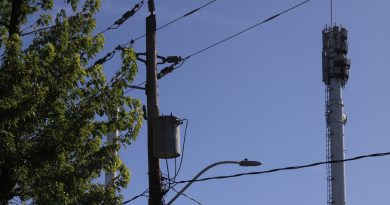Vape Recycling: Handbuilt Lobbies State Senators To Regulate eWaste
Earlier this year, I found myself researching the peculiar conundrum of “disposable” vape products, which, I noted, everyone in my office used, and which, I also noted, seem to litter many a parking lot in Southeast Michigan. Did these devices (which at that time I had no experience with) not have the little “don’t throw in the garbage” icon on the packaging? Did people not take them to their local eWaste facility, as they should know they’re supposed to? What’s the deal with this? I stepped up my efforts this past week by formally requesting that the issue be investigated with state senators including Senators Jeremy Moss and Sean McCann, respectively the heads of the Regulatory Affairs and Energy and Environment Committees in the Michigan Senate. It is unlikely that we will see motion on this any time soon, but I wanted to chronicle where we are in the process.
The Insidious Problem of Not-Recyclable Vape Pens
I am not, by any means, the first person to note this issue, and there’s a surprising amount of pretty decent data on the subject, much of which I’ve only discovered in the past six months. There’s also some more dubious commentary. A study from the UK shows that disposal of lithium-ion vapes in that country alone might well be enough to build a thousand-some electric car batteries each year. This squares with my very, very rough napkin math in my original article, which suggested that vape waste was equivalent to something to the order of several thousand to as many as twenty thousand electric car batteries each year. Ending up in landfills. Some of which, I might add, are now catching on fire because of how many lithium-ion batteries are in them. I don’t need to tell you what happens when plastic catches on fire.
Of course, consumers who, like myself, grew up in an era where we were taught that recycling was great and that there were certain things that didn’t go into the trash (this was learned in civilized jurisdictions, not Michigan, mind you), often do actually hold onto their vapes. Like, a kinda sorta surprising percentage of people just hold onto them, thinking that maybe one day this industry will get it together– possibly as many as a third of all vape users report collecting their vapes for, well, maybe not recycling them later. Observed Vice:
Any vape user worth their salt has one. A drawer, a dish, a bag, a box. In the case of one friend, a vase filled with used vapes. Sometimes there’s a few puffs left inside, reserved in case of emergency. But there they lie, piled on top of one another, inert, belly-up, like dead electronic fish. It’s depressing.
And we can’t exclusively blame either the industry or the state. The state, by its own admission, has done a lousy job of managing recycling, and Michigan’s recycling rates rank among some of the worst in the country. It could be because we love building landfills and then building ski slopes on top of them. Of course, we could nitpick and say that technically Mt. Brighton wasn’t built with municipal waste, like this project in Denmark was. But the state’s recycling numbers just frankly suck. Meanwhile, the cannabis industry in Michigan, which is currently undergoing a supply glut that has resulted in weed being, well, basically free, has enjoyed low taxation, minimal regulation, and a highly competitive market.
The state doesn’t want to slow their roll because of all of the tax revenue the industry brings in, and the industry is not going to respond to requests to clean up its eWaste without a legislative mandate. This makes lobbying challenging, because Democratic lawmakers, enjoying their first majority in 40 years thanks to the ability to finally fix gerrymandering, well… seem more focused on putting out fires than they do in figuring out broad strategies for environmental improvement. (Yes, I’m still mad that there’s been zero movement on fixing transit in the state).

The Challenge of eWaste, Generally
As I wrote about before, eWaste is notoriously tricky to recycle, because specialized electronics include specialized materials. Many moons ago, back when consumer electronics were powered by NiCad, NiMH, and other technologies as well as Li-ion, we used to read about the environmental hazards of eWaste recycling from recyclers interested only in extracting gold from computer chips. Gold is, of course, a highly valuable metal in electronics for a few reasons: in spite of how expensive it is, it’s highly conductive. It doesn’t corrode or tarnish. And, importantly, it can be layered onto another surface with but a tiny film, meaning that you don’t need to use much of it.
Fast forward to 2023, and gold news is old news. Now, the big thing is lithium-ion batteries that are going to supply the 9,000-lb. SUVs that will decarbonize transportation (because we all know that there’s no other way to get to zero-carbon except through 9,000-lb. SUVs!). The problem with lithium-ion batteries is that they comprise rare metals, plastics, and toxic solvents, all in a single package. Recycling them necessitates highly sophisticated machinery that can deal with toxic fumes emitted from melting plastic. It is possible to reduce the rate of plastic in the recycling equation, but this requires similarly sophisticated machinery to be able to break down vape pens into their constituent components.
One issue that has arisen in conversations with stakeholders is whether it’d be even possible to include nicotine vapes, or Electronic Nicotine Delivery Systems, as the FDA calls them. One respondent, a manager of a local dispensary, said he would be totally into the idea of collecting vapes in the store for recycling, but didn’t want to touch ENDS products unless he had ironclad assurances that the FDA wouldn’t be on his case about handling unregulated tobacco products without the appropriate licensure. A state official suggested the same to me in a different conversation, so I’ve been trying to get in touch with the FDA’s media representative on these products while working some back channels.
I will be updating the blog with new coverage of this issue as I try to get feedback and buy-in from respondents, which have been limited outside of my communication with state government (supportive but without any ability to actually facilitate a solution), and smokers (who think it’s a great idea but can’t necessarily be entrusted to fix the problem themselves as individual consumers). To date, I’ve only gotten one hard no, and it was from House Of Dank, which is sort of the Dollar Store of dispensaries in Michigan. Everyone else is like, “yeah, man, let’s get it going! How do we do it!” We’re working on it. It’s just going to take some time.
Do you smoke vapes for cannabis or nicotine? Take the survey! Read about vape safety here in a sidebar article and follow along with the goings-on on this page. Or, become a contributor to Handbuilt today and support efforts to build a greener world. The FDA had not responded to a request for comment by the time of publication.




